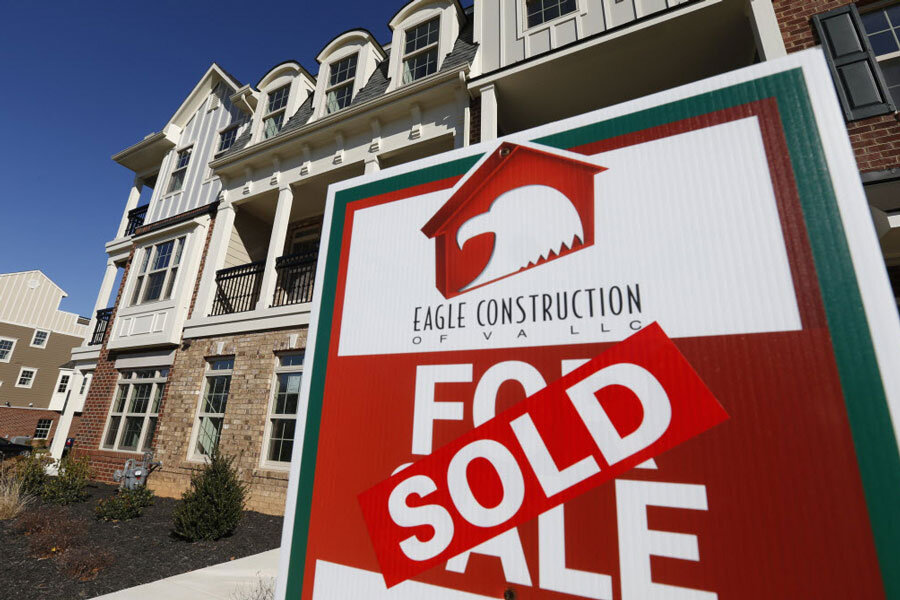Home prices up, ownership down: whither the American Dream?
Loading...
| Washington
Home prices rose in September from a year earlier at the fastest year-over-year clip in 13 months – a sign of continued momentum in the US housing market.
But the price gains, shown Tuesday in the latest release of the Standard & Poor’s Case-Shiller home price index, aren’t all good news. Soaring home values have some market watchers wondering if a new price bubble is forming.
In other news this week, the median price for previously owned homes stood at its highest October level since 2005, when the pre-recession housing boom was still in full swing, according to National Association of Realtors data cited by the Associated Press. October's median sale price was $219,600.
The mood is very different from a decade ago. Gone is any feeling that a house can also be an ATM, where forecasts of rising prices will allow steady tapping of home equity for cash. And if ownership still looks like a good financial move to most Americans, fewer can afford to do so than in the past. The overall rate of homeownership has been declining – in stark contrast to the early 2000s housing boom – and some economists expect it to keep edging down over the next decade.
It’s not that ownership has faded as an aspiration, or that no Millennials are buying homes. The reality is just that the current housing market remains under stress: Rents are high, and so are home prices, and low interest rates don’t fully make up for slow wage growth.
“The rental affordability crisis we’ve been enduring for the past few years shows no signs of easing, especially as income growth remains weak,” Svenja Gudell, chief economist at the housing website Zillow, wrote on the firm’s website last week. “It will take a lot more supply, and a lot more renters-turned-homeowners, to fully reverse this trend.”
The current state of the market appears rooted in the lingering effects of the financial crisis, not in a young generation that has chosen en masse to opt out of ownership.
Some 69 percent of younger adults (age 18 to 29) in a May 2015 nationwide poll, for instance, called owning a home a “smart and achievable long-term financial decision,” similar to the 72 percent of older adults who chose that same description.
And many Millennials are acting on that desire. Their generation accounts for two-thirds of first-time home buyers, as they increasingly move to form households and start having kids.
The challenge for now is affordability. Fully 18 percent of the under-30 adults in that same poll described homeownership as “smart but unachievable,” compared with just 12 percent of older respondents to the survey, the Allstate/National Journal Heartland Monitor poll.
And judging by other polls in recent years, owning a home has remained among the economic milestones that people associate with the phrase “American Dream.” Not that it’s a must. To many people, the core of American Dream about general opportunity and freedom rather than the details of things like housing or college.
To some extent, many economists say, the nation’s homeownership rate was pushed beyond sustainable levels during the early 2000s. By 2005, some 69 percent of Americans lived in dwellings they were buying rather than renting, up from 64 percent in 1995. Today the level is back just a bit below 64 percent.
Why might homeownership keep edging down?
One factor, identified in a recent Urban Institute analysis, is that the groups projected to contribute the most to population growth – Hispanic and black Americans – have historically had lower than average ownership rates. Another factor, the report says, is the lingering impact of the 2008 financial crisis.
Even today the aftermath of that recession and its attendant wave of home foreclosures is affecting the supply of homes for sale and the creditworthiness of borrowers. Many would-be sellers are still waiting for values to recover to the point where a home sale could pay off their loans.
Young would-be buyers have also been affected. The crisis added to Millennials’ student debt burdens, as many young people saw bolstering skills as their best option in a protracted weak job market. Tough times also delayed the formation of new households as young people put off moving away from parents and start having kids.
By the Urban Institute forecast, the US homeownership rate could dip to 61.3 percent by 2030.
America isn’t becoming a nation of renters. It’s already a nation with lots of renters, lots of owners – and many in both camps who could use more affordable housing options.
[Editor's note: The original version mischaracterized the October data for previously owned homes.]








